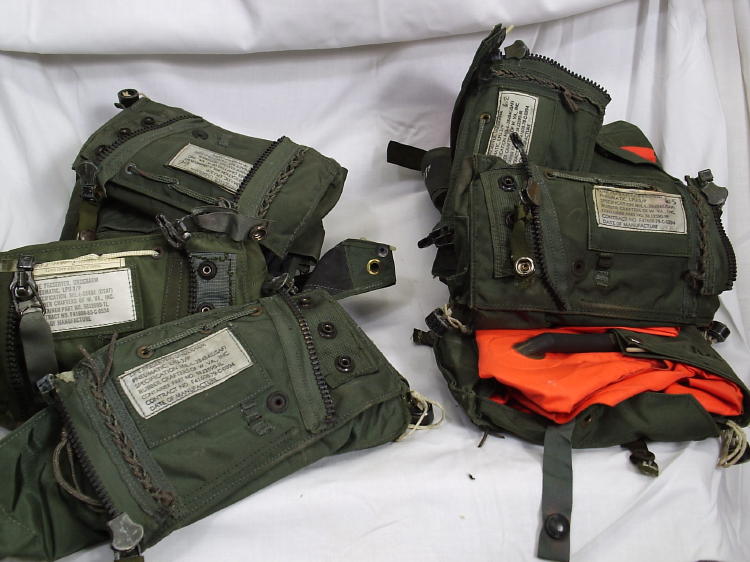Click on the title for the page dedicated to this post and the featured header image, credit: surclaro.com.
For every combat mission during my two tours in Vietnam, pre-flight preparation began with a briefing covering the latest intelligence information. Of particular interest to aircrews was the heading and distance from the target area to the nearest SAFE area (Selected Area For Escape and Evasion, also known as E&E). This acronym carried more than an hint of irony, because deep into enemy territory “safety” is a relative concept.
Targets worth our attention were also worth defending, which meant lots of bad guys on the ground who didn’t appreciate being bombed. In the history of modern warfare, no airspace has been more heavily protected than that of North Vietnam. It was a classic example of defense in depth, with overlapping lateral and vertical coverage by everything from rifles to surface-to-air missiles, or SAMs, to well-coordinated attacks by Migs.
If you took a hit over the target and the jet was still under control, your first priority was to turn toward the nearest SAFE area, the two most significant characteristics of which were distance from major population centers and rugged terrain. Depending on target location, the nearest SAFE area might be deeper into enemy territory. And while turning away from your home base might appear to be the worst option, it made sense as an initial action until you had time to assess the severity of the battle damage.
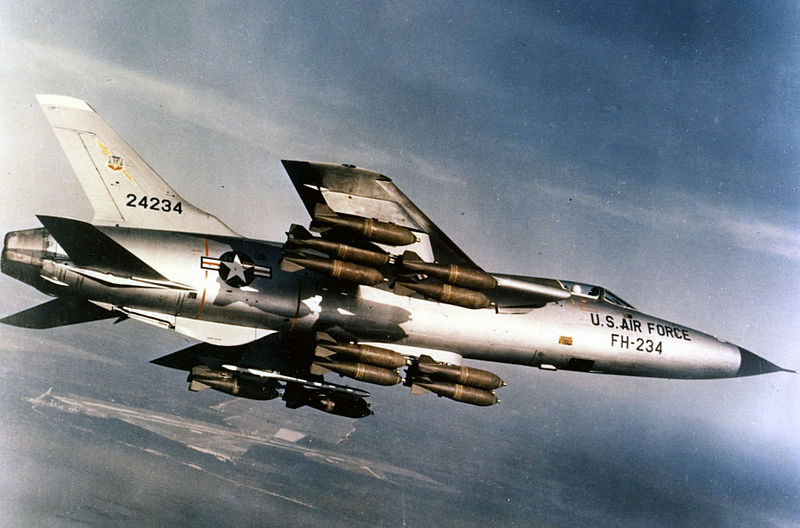 For a major portion of the war, the F-105 Thunderchief was the workhorse of the USAF bombing campaign in North Vietnam. “Thud” squadrons and their pilots suffered some of the highest loss rates of the conflict. Many factors contributed to this tragedy, but the focus of this post is the personal account of one young Thud pilot’s experience after taking a catastrophic hit over enemy territory.
For a major portion of the war, the F-105 Thunderchief was the workhorse of the USAF bombing campaign in North Vietnam. “Thud” squadrons and their pilots suffered some of the highest loss rates of the conflict. Many factors contributed to this tragedy, but the focus of this post is the personal account of one young Thud pilot’s experience after taking a catastrophic hit over enemy territory.
I received this from a friend, who received it from a friend of his. I’ve elected to publish it in the Visitor’s Story logbook because it’s a fascinating first-person narrative of an event that carries personal significance to my combat experience.
The account begins with the email sequence as I received it, and remains unchanged from the original with the exception of my editorial notes to provide non-flyers with additional information that I thought might help explain some of the aviation terminology. This is a long post, but well worth the time to read it. I apologize in advance if you disagree. The verbatim text follows:
Norm:
I’ve been enjoying the F-105 stories in your Thunder Falcon e-mail newsletters. I’ve pasted below a somewhat different (and longer) story told by 25-year-old F-105 pilot 1Lt Kenneth Deane Thomas, Jr. He told this story two days after he was shot down in SEA on 23 March 1966 and came down on top of a mountain in Mu Gia Pass in Laos. He spent the night on the mountain and had to hike into North Vietnam to be rescued.
I found the story on a set of tapes in the AF archives at Maxwell. At the time, Bob Krone was the 469 TFS Ops Officer who had a unique approach to documenting his squadron’s history by recording stories on audio tape cassettes. This tape was one of 16 Bob recorded during his combat tour at Korat that found their way into the Archives. I had AFHRA copy the tapes to CDs and John Revak transcribed the narrative of Thomas telling of his shoot down and rescue. Thomas was telling his story to five members of his squadron including the PE [Personal Equipment, i.e. flight/survival gear] officer and technician, and the flight surgeon. I added the paragraph at the end of Thomas’ narrative to summarize what he recorded on a second tape cassette.
On 5 May 1966, less than two months after telling this story, Kenny Thomas was KIA. Howard Plunkett F-105 Historian
Lt Thomas’ story:
I was at 9,000 feet, doing better than 400 knots. I was jinking pretty hard. I think they got me with the luckiest shot they ever made. They tell me that the coordinates of the thing were the 068 radial at 63.5 miles out of channel 89. The ultimate reason I left the bird was because it quit flying pretty violently.
Actually, I think I was hit, probably, in the base of the rudder on top of the fuselage, because simultaneously with the explosion I got the Rudder Travel Light. I lost my Primary #1 Hydraulic System almost immediately. I got an Overheat Light, pretty soon thereafter, about 10 seconds afterwards, and she was trying to yaw pretty hard to the left. It took about half right rudder and some rather sloppy stick movements to keep it level and climbing. I slowed to 300 knots because I didn’t want to shed too many pieces off the bird and it flew for about a minute and a half. I was almost exactly a 270 degree heading because that was where the highest hills were, above the fence [boundary between “friendly” and “unfriendly” territory], and that looked like the best place to get out.
And, after about a minute the Utility Systems bled down completely and the Stab Aug went off the line. It got worse and worse and I recall telling the other people in the flight, giving them a sort of running commentary on what was happening to the airplane. The last thing I remember saying was, ‘OK, I’m losing control, I’m getting out.’ I said that just as it snapped very hard to the left and I went out actually inverted, almost exactly upside down. The other people in the flight told me after that the bird made a couple of quick spins and then straight nose up and then just fell like a piece of aluminum foil or something after that, no relationship to an airplane at all. The engine was running real fine the whole time. I was real happy about that, it never gave me any trouble at all.
As I said, I was going for the highest hills there. The peaks were something over 6000 feet high and a pretty long ridge. My main concern at the time was just getting away from the bad guys. The terrain was really pretty rugged, so it looked like a good place.
Actually, the toughest part of the whole two days was the bailout. That bothered me more than anything else, leaving the airplane. On bailout, I lost my helmet and got smacked above the left eye by a piece of equipment, which I think I probably was my clipboard.
Immediately after the chute opened I realized I didn’t have my helmet and I was bleeding over my left eye, which I pretty well stopped with a handkerchief I had. I checked over the terrain below me, looking out for people mostly, not necessarily worried about the woods. There wasn’t a sign of any type of civilization or villages or anything else anywhere within several miles so I thought I was in a relatively safe area.
I almost went down on the North Vietnamese side of the ridge. A pretty tricky updraft there along the mountain chain and it took me back up 1000 feet and blew me another 2 miles across the ridge and down the Laos side. I kept my seat pack under me, because of the probability of landing in the trees. I was really glad I did because when I did come down I got a terrific thump right on the bottom of the seat pack by a branch that took the blow I would have gotten anyway. I hung up in the tree about 50 feet for just a second and sort of slid and slipped until I was down. Then I actually stopped and my feet were about 2 inches off the ground, which was pretty ideal.
I got out of the chute and turned off the beeper [automatically actuated emergency locator signal transmitted on “guard” channel monitored by all aircraft] so I could pull out my two-way radio and talk to them. I transmitted about 3 or 4 times that I was down and OK and I tried to get somebody else to talk to me. I could just barely hear Captain McCurdy answer me but I didn’t realize he was talking to me at that time. I thought he was calling the rescue aircraft. The reason I couldn’t hear him too well was they all thought I was on the other side of the ridge. I should have been, from the point where I bailed out, but the wind had blown me quite a bit further than they thought.
As far as survival gear that I had on me; I had the standard seat pack of course. It contains quite a number of things, one of which, supposedly, was canned water. But the little compartment where the two cans of water were kept had been blown open; the door was completely blown off of it by the force of the wind I suppose from ejection. So, I didn’t have any water, which later gave me some problems. For about 16 hours I didn’t have any water.
On my own personal survival gear, I have always carried some bandages, waterproof safety tablets. A few things like that, matches, signaling devices, and water proof plastic containers that I carried in my g-suit. In my survival, not actually a vest, it’s one of these … a waist band, I had a .38 with 30 rounds of tracer ammunition with about 15 rounds of straight ammunition. Ten pen gun flares, which came in handy. I had two day-night type standard flares, plus three more in the kit, plus two mirrors. I had my own radio, the radio in the pack with the beeper, the radio in the chute, so I wasn’t hurting for communication devices.
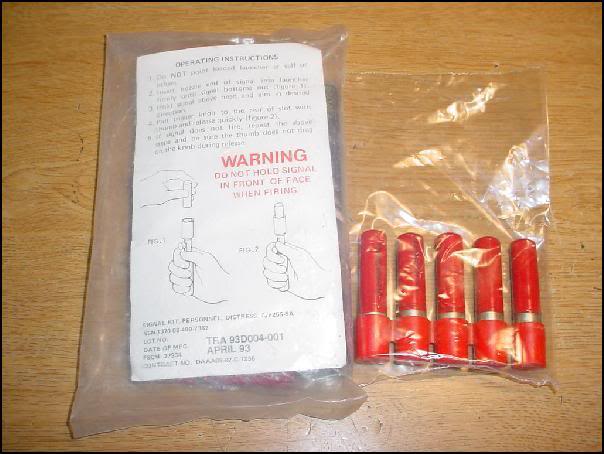 [The pen gun flare system was designed as a location marking device. You loaded a small flare into one end and fired it with a spring-loaded trigger to alert SAR (Search and Rescue) aircraft as to your position. We practiced using them in survival training and were cautioned not to fire them directly at the rescue aircraft because they might be misinterpreted as tracer fire from the enemy.]
[The pen gun flare system was designed as a location marking device. You loaded a small flare into one end and fired it with a spring-loaded trigger to alert SAR (Search and Rescue) aircraft as to your position. We practiced using them in survival training and were cautioned not to fire them directly at the rescue aircraft because they might be misinterpreted as tracer fire from the enemy.]
As far as rations, there were C-rations in the kit and I consumed a few of them. Not too many, I never really was awfully hungry but I did want to keep my strength up a little bit. Keep hunger down and at the same time I wanted to ration them out because, frankly, after the first afternoon I didn’t know how long I was going to be on the ground.
Just looking through the stuff here, some gear. I think — run through actually the things that were most important to me. Basically, it was my radio, standard survival type radio, two-way communication, 243.0 [The standard “guard” channel frequency]. I would never have been found without that. There was definitely no way they could have gotten me initially or even the next day when they did pick me up. The radio that I used most of the time, in fact, I used it for all but one of my communications, really served its purpose well and it’s still going strong, even though it’s got six inches broken off the end of the antenna when I fell off a rock when I was talking on it. In addition, I had another radio and a beeper I was talking about.
The second most important thing to me up there, and I can’t impress this upon people too much, was a 200-foot nylon tape-type rope that most of us carried in our g-suit. It was initially carried by most of us to get down out of a tree after we hung up in a chute. As I said, this problem I didn’t have. But, I’m sure I couldn’t have gotten down the mountain without it. Three times I went down cliffs that were anywhere from 50 to 75 feet high using the thing. A lot of times when the terrain was too rugged to carry my little pack that I had, I could let it down first on the rope and then follow it down. Or, just, mainly, getting down in some of the places that were too steep to crawl or slide or anything else.
Maybe I didn’t say enough about terrain a while ago. I’m getting a little out of phase here. It was the most rugged place I’ve ever seen in my life. Almost all of the slopes were either straight down or something like 60 degrees. Most of the soil was crumbly and rocks weren’t too stable, you could kick them off. It was really drastically hard getting down. I completely wore the seat out of my flight suit. I mean completely, just sliding down the hills, over rocks, things like that.
The jungle itself was awfully thick and hard to get through. In places it would take me several minutes just to make a few feet through the undergrowth because of the vines. There was one point of survival equipment, which I really wish I had, and I’m going to try to work something out before I go out that direction again. That’s a machete or at least a longer knife than I normally carry to hack away the vines.
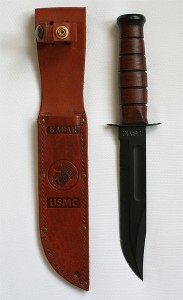 That leads me to the third most important thing I had, was my survival knife that I had sewn in the back of my g-suit leg. It was what we call a Navy Knife. It was really a great thing to have. I used it for so many different things, cutting open different parts of my gear that were sewn up so securely that they were hard to get loose, or cutting risers out of the chute when I went down. Once I even crawled down a hill about 75 feet or so, I thought I was making good progress until I came out to a 500-foot bluff and it wasn’t too good. To get back up, it was so steep, all I could do was actually dig the knife in under tree roots and use that for something to hold on to as I was pulling myself up.
That leads me to the third most important thing I had, was my survival knife that I had sewn in the back of my g-suit leg. It was what we call a Navy Knife. It was really a great thing to have. I used it for so many different things, cutting open different parts of my gear that were sewn up so securely that they were hard to get loose, or cutting risers out of the chute when I went down. Once I even crawled down a hill about 75 feet or so, I thought I was making good progress until I came out to a 500-foot bluff and it wasn’t too good. To get back up, it was so steep, all I could do was actually dig the knife in under tree roots and use that for something to hold on to as I was pulling myself up.
More on the gear. The next most important thing that I had was the water bottle. Like I said, it was 16 hours from the time I went down when I finally got to water. And I was really hurting for something to drink by that time. I happened to find a little spring where I could get water. I filled up a 3-pint plastic water container, treated it with iodine pills, and waited the prescribed 15 minutes, drank 2 pints of it, and got 3 more and I pressed on. But all day I was constantly thirsty, because of the heat, all the exercise of walking, and besides which, I imagine, my physical condition was leading to dehydration because of fatigue and a few other things too.
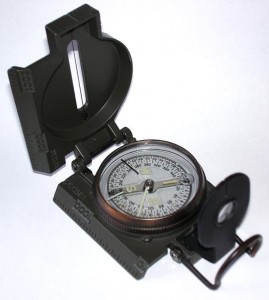 After that I can’t really classify stuff in any order of what was best and what wasn’t. I had a real good compass. I’ve forgotten what they call the thing. It’s a lensatic compass. It’s top-drawer equipment, although most of the time I couldn’t use the thing because there was no possibility of trying to maintain any sort of a heading. They had told me a heading of 350 was my best escape heading, but that’s like asking a man to climb the side of the Empire State Building just to get on the other side, you know. I went down where I could and there was no real chance of maintaining a particular direction.
After that I can’t really classify stuff in any order of what was best and what wasn’t. I had a real good compass. I’ve forgotten what they call the thing. It’s a lensatic compass. It’s top-drawer equipment, although most of the time I couldn’t use the thing because there was no possibility of trying to maintain any sort of a heading. They had told me a heading of 350 was my best escape heading, but that’s like asking a man to climb the side of the Empire State Building just to get on the other side, you know. I went down where I could and there was no real chance of maintaining a particular direction.
[In survival training, we were taught how to use a map and the lensatic compass to orient ourselves in relation to a last known position, then pick a heading to a destination, and take a bearing on a physical object in the distance as a visual reference. In open country, that works really well. In the forest, you might have to sight on a particular tree as far away as you can, walk to it, and repeat the process. Dense jungle, where your sight line is restricted to a few feet, presents an entirely different problem.]
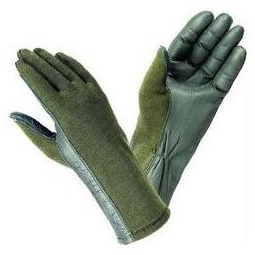 Something that I really wish I had in the seat pack was another pair of gloves. My right glove started ripping out at the seams after about an hour on the ground. By the next afternoon it was almost completely gone. My right hand took a little more of a beating than my left one did. I got probably somewhere in the vicinity of 20 chiggers buried in the back of my right hand. My left hand is fine, no problems at all.
Something that I really wish I had in the seat pack was another pair of gloves. My right glove started ripping out at the seams after about an hour on the ground. By the next afternoon it was almost completely gone. My right hand took a little more of a beating than my left one did. I got probably somewhere in the vicinity of 20 chiggers buried in the back of my right hand. My left hand is fine, no problems at all.
I had asked the SAR troops, if I had to spend another night and they were going to kick out another package of goodies out to me, be sure and put a pair of gloves in it. And they had done so, even though they never got around to kick the thing out. It was what I needed at the time.
Just looking around here at some of the things I didn’t use. I’m so glad it was a snakebite 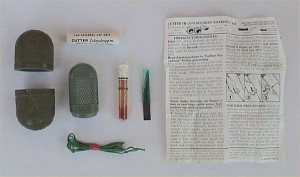 kit; in fact I had two of them. I had lots of matches; I only used two or three of them, in the dark up under a ledge at night to take a quick look at something. I didn’t want to build a fire even though I was terrifically cold because I didn’t know who else was in the area.
kit; in fact I had two of them. I had lots of matches; I only used two or three of them, in the dark up under a ledge at night to take a quick look at something. I didn’t want to build a fire even though I was terrifically cold because I didn’t know who else was in the area.
About 2:30 in the morning I was glad I hadn’t because over the next ridge, about a half a mile away, somebody let go three shots at some monkeys. It just didn’t do anything for my peace of mind because I didn’t know whether they were good guys or bad guys and I wasn’t going to investigate further.
The rest of the survival gear I had was good stuff. The first time I was spotted was with a smoke flare. One of the A-1Es [The Skyraider, a single-seat, single-engine attack aircraft with a long and illustrious career from the late 1940s through the early 1980s] was coming right down the valley at me and I waited until he was about a ¼ mile out, popped a smoke flare and whipped it around, and he spotted it just as he went overhead.
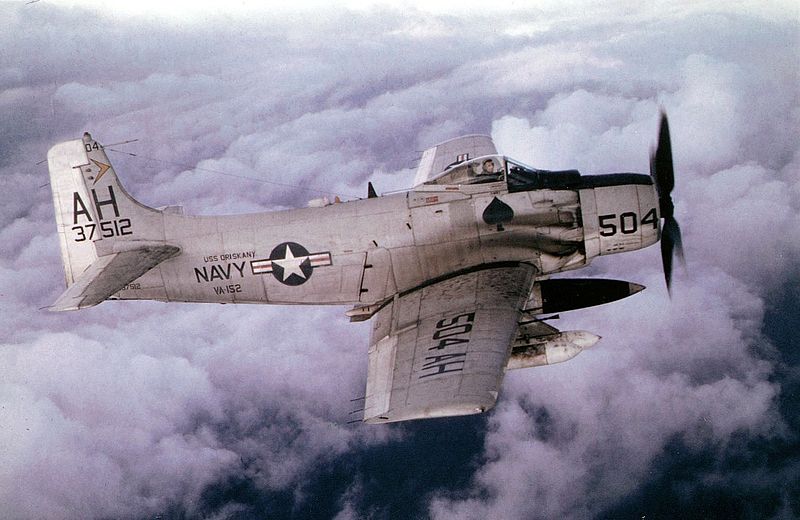 The pen gun flares were pretty hard to see up there. In fact I didn’t see any of them in the daytime. I fired off about four of them in the daytime when they were pretty close to me and they should have been able to pick them up with the visibility involved and they couldn’t. When it was almost dark, one of the Sandys saw one and got another good general idea where I was. And then, as they were talking, well I was actually talking to the HH-3C [“Jolly Green” helicopter used extensively for SAR operations during the war] and in my position because I could see him getting ready to kick off a bundle of survival gear. I fired one off under his nose when he was about 200 yards away and that gave him a real indication of where I was.
The pen gun flares were pretty hard to see up there. In fact I didn’t see any of them in the daytime. I fired off about four of them in the daytime when they were pretty close to me and they should have been able to pick them up with the visibility involved and they couldn’t. When it was almost dark, one of the Sandys saw one and got another good general idea where I was. And then, as they were talking, well I was actually talking to the HH-3C [“Jolly Green” helicopter used extensively for SAR operations during the war] and in my position because I could see him getting ready to kick off a bundle of survival gear. I fired one off under his nose when he was about 200 yards away and that gave him a real indication of where I was.
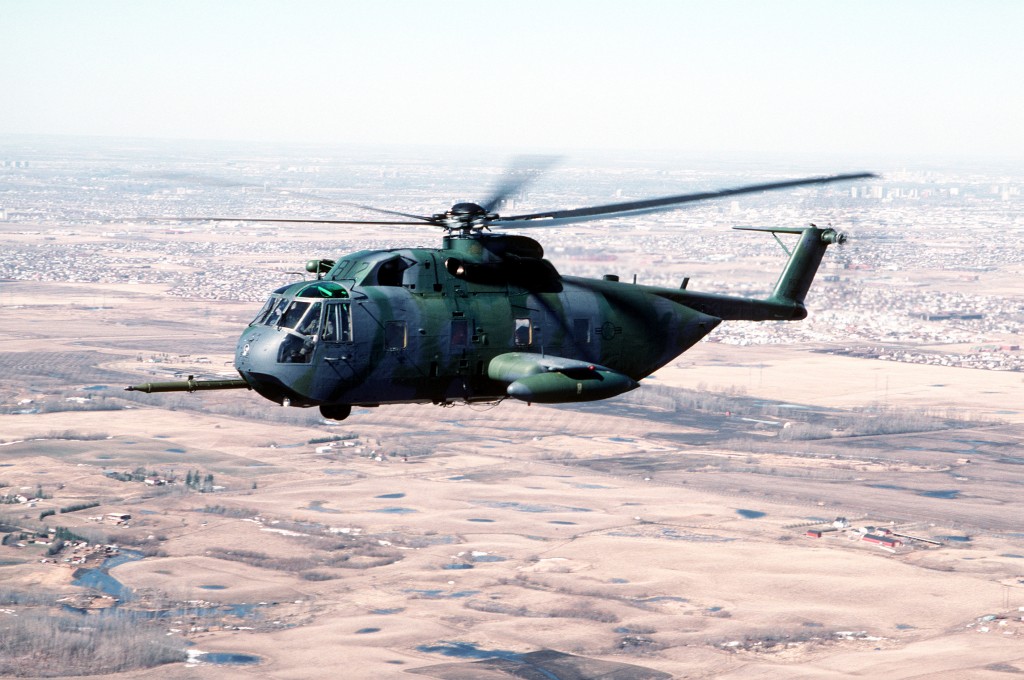 Tracer ammunition — I was always told that was the thing to carry in the jungle because that’s the only thing to get up through the trees. [I don’t remember ever being told this and never carried tracer ammo for my personal sidearm. It doesn’t seem like a very good idea.] In a great big heavy growth, and I went through some later in the day, I think this was true. I fired a few rounds of tracer later in the day, in the afternoon to show them where I was, and it got up through the canopy. I don’t doubt that. Whereas the little pen gun flares might not have. But in the lighter growth, plain little every day trees, these little pen gun flares are pretty effective. They do make more light and they’ve got a terrific bang when they go off. They really get on up through the branches.
Tracer ammunition — I was always told that was the thing to carry in the jungle because that’s the only thing to get up through the trees. [I don’t remember ever being told this and never carried tracer ammo for my personal sidearm. It doesn’t seem like a very good idea.] In a great big heavy growth, and I went through some later in the day, I think this was true. I fired a few rounds of tracer later in the day, in the afternoon to show them where I was, and it got up through the canopy. I don’t doubt that. Whereas the little pen gun flares might not have. But in the lighter growth, plain little every day trees, these little pen gun flares are pretty effective. They do make more light and they’ve got a terrific bang when they go off. They really get on up through the branches.
There was a pair of real heavy wool socks in that kit, too big for anybody who is less than 8 feet tall. But they came in to a real good use during the night when I was pretty cold. I was shaking all over I was so cold and I pulled the things actually over my hands and way above my elbows practically up to my shoulders and they helped me stay warm.
One other thing in this kit that some people kind of thought it was funny I carried with me and I didn’t take it for a reason that I ultimately used it, was my LPU, my underarm life preserver. I took it with me originally because I wanted to use one as a pillow if I had to spend the night out there, which I did. It sure beat the rocks that I was laying on.
But, I was picked up eventually because of these things. I was in a clearing and the guys were circling me. I know they could see down in the clearing to see where I was. But, I was so dirty and talk about camouflage, I looked like the rock I was standing on and after they had gone by twice I was getting kind of desperate. I suddenly realized the best high visibility thing I had was my LPU.
So, I pulled it out of the pack, popped the other one open and started waving it around and they immediately saw me then. You know it was just a matter of time until they got me out. I haven’t before carried a bright colored cloth, flag of any sort, and I’m going to from now on. I realize that the high-visibility color was the only thing that got me out. I was just lucky I had my LPU. I might have thrown it away.
Now I was told by some other people up at Udorn the other night that I left a good piece of high visibility material. And it is true. I could have taken my knife and cut the bright colored covering flap off the one-man raft that was in the pack. I left the raft by the way. I didn’t figure I had too much use for that. I know it makes a good bed and things like that in the jungle, but it was a little more than I wanted to add to all the other stuff because the terrain was so bad. And I could have cut that piece of flap off of it and used that.
One other thing that I left behind that I hadn’t intended to. I thought I had everything that was important to me, but, I left the little strobe light, high visibility light, with the parachute harness. I actually went all over the stuff pretty well before I left to get everything but I missed that one.
Oh yes, my boots. I think somebody was worried about my boots. I don’t know who, but I got the indication when I got back that it bothered somebody. The same old boots I have worn since my first flight in a T-37 in pilot training. I had zippers sewn inside of them. Everybody always told me that if you ever go down in the jungle you’ll be sorry because the zippers will rip out. There was a small rip in the left one that was there before I jumped out and I don’t think there was a stitch missing that wasn’t there when I took off that day, so that’s not bad.
[In Undergraduate Pilot Training we were issued two pairs of leather flight boots, summer and winter, both about ten-eyelet and not very easy to get on and off. You could lace a heavy metal zipper into the front of the boot, or have a zipper sewn into the inside edge of 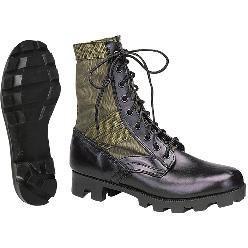 the boot from the ankle to the top. One negative consideration was the possibility of a zippered boot being more likely to depart the wearer’s foot during the shock of a parachute opening, but in my experience, both of these modifications were widely used by fighter pilots.
the boot from the ankle to the top. One negative consideration was the possibility of a zippered boot being more likely to depart the wearer’s foot during the shock of a parachute opening, but in my experience, both of these modifications were widely used by fighter pilots.
Then came “jungle boots,” a combination of leather and nylon that supposedly was much better adapted to wet environments. They even had small, brass drain holes on the inside instep. In my experience, most fighter pilots were more concerned about the reduction in ankle support caused by flexible nylon in relation to heavy leather. The reasoning was simple, that wet boots were less of a problem than the possibility of hurting an ankle on a parachute landing in rough terrain.]
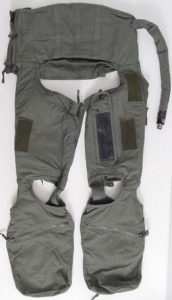 I left the g-suit [a tight, inflatable piece of flight gear that fits around the abdomen and legs] on all the time because, first of all, I had a lot of gear in the pockets and I had the knife sewed to the back of one leg and the rope to the other, and I probably would have been naked from the waist down after all the stuff I walked through if I hadn’t had it on. It took a lot of beating and was really chewed up pretty badly and my flight suit would have been absolutely ripped to pieces in the brush, rocks, undergrowth of all sorts, vines with barbs on them. I really got scratched up with something that looked like a rose bush once.
I left the g-suit [a tight, inflatable piece of flight gear that fits around the abdomen and legs] on all the time because, first of all, I had a lot of gear in the pockets and I had the knife sewed to the back of one leg and the rope to the other, and I probably would have been naked from the waist down after all the stuff I walked through if I hadn’t had it on. It took a lot of beating and was really chewed up pretty badly and my flight suit would have been absolutely ripped to pieces in the brush, rocks, undergrowth of all sorts, vines with barbs on them. I really got scratched up with something that looked like a rose bush once.
I had a lot of gear I didn’t use but I wasn’t down there very long, relatively speaking. I would have used most of it including medicines … oh, I forget to tell you about that.
The second thing after I got down, and tried to make radio contact, I had to stop the bleeding over my left eye and I didn’t want to take the time then for me to work it over too much. I’ve always carried bandages in my right g-suit pocket and I got one of them out. A pressure type bandage and just wrapped it around my head good and tight and stopped the bleeding.
I tried to salvage my parachute canopy, which would have been something for me later on at night. But there was no way to get it down from the tree. About that time I decided it was time to get away from the parachute because if anybody was down there looking for me … bad guys, that thing was sticking up in the tree was going to make a pretty good signal.
So, I gathered up my gear and took off. I climbed about 300 feet up this ridge. I actually, was down in a little ravine, way up on the side of this mountain. I got on the top of this small ridge that ran down from top of the mountain. It was an ideal place for a pickup, I thought. It was relatively flat right there and good enough for a chopper to get in over me. The tree canopy wasn’t too thick; trees were just stubby little things 15 to 20 feet tall. They could have gotten their canopy penetrator device down through there with no trouble at all.
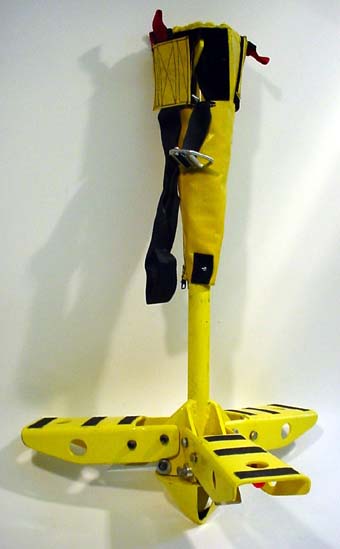 [The canopy penetrator was a rescue device designed for the helicopter extraction of a single survivor from areas unsuitable for landing. Attached to the end of a cable and winch system, it had three fold-down “arms” in a zippered pouch, two of which, when rotated 90 degrees from their stowed position, served as a seat for the survivor. A heavy leather strap attached to the top of the device served as an upper body restraint, crucial in the event the survivor lost the ability to hold on during the extraction.]
[The canopy penetrator was a rescue device designed for the helicopter extraction of a single survivor from areas unsuitable for landing. Attached to the end of a cable and winch system, it had three fold-down “arms” in a zippered pouch, two of which, when rotated 90 degrees from their stowed position, served as a seat for the survivor. A heavy leather strap attached to the top of the device served as an upper body restraint, crucial in the event the survivor lost the ability to hold on during the extraction.]
But, here is where the whole thing came in, I could have been picked up an hour after I punched out but the wind just wouldn’t allow it. Up on the top of the mountain there were some really terrific gusts. Like I said, it blew me up 1000 feet and over 2 miles before it let me back down. The HH-3C nearly hit the ridge the first time he tried to come in, hit a downdraft and I heard him say on the radio to one of the other choppers that he had full power and 60 degrees nose low and he wasn’t moving forward, he was moving backwards. He kind of gave me the impression that that’s a pretty drastic maneuver in a HH-3C.
He tried, actually, to get over me four times and just couldn’t hack it without getting a running start back about mile away and going zipping over me pretty well at top speed. There was no possible way he was going to pick me up like that. After they tried several times, we talked about it a little bit, and they decided that if I could get up clear to the top of the mountain, which was about 1000 feet higher than I was at the time, maybe 1500 feet, they could pick me up there because the wind wouldn’t be as bad. So, I started up and I climbed for about two hours. I wasn’t making very good progress. The terrain was really rough and going up was a lot harder, than I found out later, going down was going to be.
I almost got to the top, actually about 500 to 600 feet, and I ran into a place that just couldn’t be climbed. I went both ways from the point where I was for quite a ways. There was just no way to get over this bluff.
About that time they decided it was too windy up on the top to put anybody down. They had talked to me about putting a Pararescue man off on the top and letting him climb down to me, throw me a rope over this ledge and get me up and go on up the top but they couldn’t even hack that.
It was still pretty rough at about the time they were going to leave me. So, they did kick a survival kit out to me. They told me they had water in it, a couple of radios and some food and I envisioned what else was in it. They had me talk them into position; they were making a running pass at me again. I directed them in, when they were close and about 200 yards; fired up a pen gun flare. They spotted that; when directly over me I said, ‘Drop now’. It went in to the hills, just a few feet above me, less than 100 feet I am convinced. I saw it against the sky when it went out of the chopper. I heard it hit the ground. I also heard it go roaring down the hill through the brush. I never found it. I looked until it got too dangerous to stumble around in the dark with all the ledges and things in there.
They told me, since then, the thing was supposed to have two blinking strobe lights on it to help people find it in the dark. The lights didn’t work when they first kicked it out. Out in the middle of the night they scared me a couple of times, because in the fog I saw lights blink. The first time it blinked about six times. The next time it ran for about 30 seconds. It pretty well scared me because I didn’t know what was going on. I thought maybe it was an artillery barrage over on the other side of the mountain or something making these regular flashes in the sky or the possibility of these lights didn’t occur to me at the time. But, even then, I got up and looked around a little bit to see what was going on. In the fog, I had no way to tell what direction the light was coming from. So, even if I had kept on looking for it, stumbling around in the dark again, I would never have found it I’m sure.
I did take my little radio. Oh, when they dropped the kit; one of the two radios in it jammed into the beeper position and was transmitting the beeper. I took my radio and shielded the antenna on one side with a piece of metal. I could get a pretty good directional fix on it. It was in the same direction in which I heard the thing go cascading down the hill. But it wasn’t that much more help. I just couldn’t get to it.
Something in the survival kit I forgot to mention that was really important to me, actually two things. But, the insect repellant stick, 6 -12 insect repellant, kept the bugs off of me in really a terrific manner. I didn’t have a mosquito bite on my face or neck or ears or anything. One of the first things I did after I got up on the ledge of the hill where I first got to, was to smear the stuff all over my face and neck. It kept the mosquitos away from me. I could hear them buzzing around at night but they never got really close to me.
Another item that I had was a standard old floppy hat that was green on one side and yellow on the other. It saved me a lot of trouble with the underbrush keeping my head protected from branches and vines and things like that.
Well anyway, I got up to a point where it got too dark to climb anymore and I found a little ledge where it was relatively safe to lay down without falling off the mountain. I spent about 10 hours, actually, there in the dark. It stayed dark an awfully long time that night. There was no place really to lay down. I was just sort of laying there with my feet hanging off the edge of the bluff. About 2:30 in the morning, I was suddenly inundated by a thunderstorm that lasted for an hour and a half. I was able to huddle back up under the ledge and stay dry, but I sure was cold. I was pretty miserable because I couldn’t stretch out and I huddled up under there with no real protection for me except the rain.
As far as the SAR [Search And Rescue] aircraft are concerned. When I was going down in the chute, actually I heard all three of the other aircraft in the flight and I could see Captain Gangol circling. He was spiraling down, keeping me in sight. As soon as I got on the ground I tried talking to him. I heard Captain McCurdy answering, but I didn’t realize he was talking to me. His transmissions were too broken up by the mountain and I was down in the ravine on the side. The first guy I really had good contact with was one of the Sandys [A-1E Skyraider]. Crown, I think it was a C-54, an HC-54. I heard him in the area. He was on the wrong side of the mountain, where they thought I had gone in, where I would have gone in but for the wind. He was over there looking for me and I could hear him. I tried transmitting but he wasn’t picking me up.
Shortly after the HCs got there the A-1Es came roaring across from the Laos side and I’m afraid they would have gone on the other side of the mountain too, except the fact that I called, ‘Sandy, Sandy this is Willow 04’. I told them, ‘You were pretty close to me. I can hear you.’ So they stayed on that side of the mountain and took around 5 or 10 minutes. They actually had me spotted, actually spotted my position within 35 minutes from the time I was down. I talked them into the general area. I never could see them really too well. I finally spotted one holding. I told them generally where I was in relation to his position. I spotted him, talked him in closer, and popped a smoke flare and waved it around. Even though the wind was pretty stiff, it blew it out away from the trees. He spotted it and told me he saw it. I felt pretty good about that right at the moment.
It took about another 25 minutes for the chopper to get there. I was in radio contact most of the time until the chopper got there. He did his best, he really tried, but there was no way he could do it. So I started up the mountain. I thought I’d have to spend the night there.
During the night something that intrigued me and also intrigued the intelligence people up at Udorn [Royal Thai Air Force Base] was the fact that I heard people on the next ridge because they weren’t particularly sure who it was. The rescue people told me there were friendlies in the area. Which I took with a grain of salt because I felt, like, by myself I was safe. If I contacted anybody I’d have a 50-50 chance to be with the wrong people.
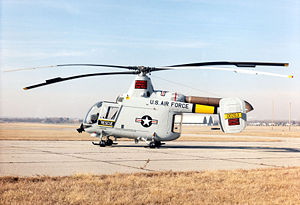 So at dawn the next morning, I headed in the opposite direction where I heard the shots during the night.
I started on up the ridge the next morning and got to this bluff that couldn’t be climbed and walked both ways for a while and decided there was no point in that. By this time they had brought in, besides the HH-3Cs, they had brought in an H-43, a littler chopper, because they thought he could maneuver a little better in the currents. But he couldn’t hack it either. The winds were stronger all during the night. In fact things were picking up especially in the thunderstorms were going through.
So at dawn the next morning, I headed in the opposite direction where I heard the shots during the night.
I started on up the ridge the next morning and got to this bluff that couldn’t be climbed and walked both ways for a while and decided there was no point in that. By this time they had brought in, besides the HH-3Cs, they had brought in an H-43, a littler chopper, because they thought he could maneuver a little better in the currents. But he couldn’t hack it either. The winds were stronger all during the night. In fact things were picking up especially in the thunderstorms were going through.
Something else that happened during the night I forgot about. It was kind of odd. There were F-4Cs or something sounded like multiple-engine jet fighters kept running down through this valley at altitudes considerably lower than the peaks. A flight, more than one, I would say probably about four of them, went through in sort of staggered trail or at least two elements of two at about 11 o’clock. And then they came back the other way someplace over North Vietnam about 12:30. Another flight went back around the other way a half an hour later and they came back another half hour later.
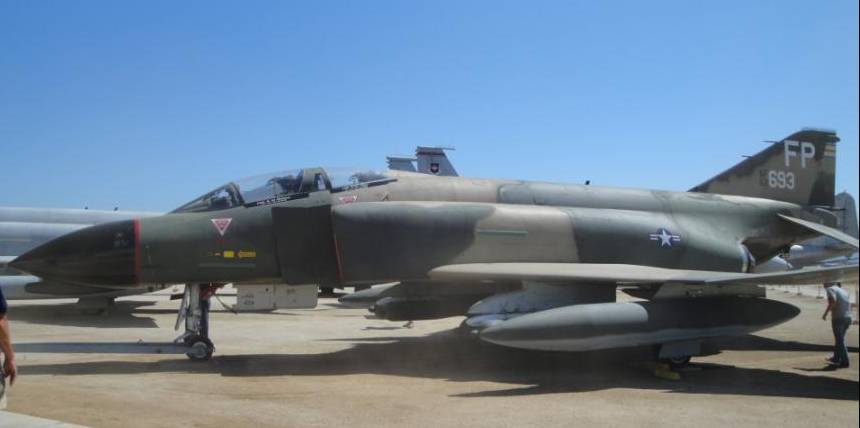 What I took to be a weather recce [reconnaissance] bird, probably an F-101 [Voodoo], came through about a half an hour before dawn, maybe an hour before dawn down through the valley and I was hoping, anyway, to find they were checking the weather out to wait for light to pick me up. About an hour later the little chopper showed up. He couldn’t hack the wind. By this time I was getting kind of disgusted too. And I talked to the Jolly Greens again. They asked me how I was doing.
What I took to be a weather recce [reconnaissance] bird, probably an F-101 [Voodoo], came through about a half an hour before dawn, maybe an hour before dawn down through the valley and I was hoping, anyway, to find they were checking the weather out to wait for light to pick me up. About an hour later the little chopper showed up. He couldn’t hack the wind. By this time I was getting kind of disgusted too. And I talked to the Jolly Greens again. They asked me how I was doing.
 I told them, except for the fact that I didn’t have any water, I was in really good shape. Then they said the nearest water was about 5 miles away on a heading of 350 degrees. I felt like saying, ‘Thanks a lot, Jack’. It’s a long, long way down there. But we discussed it a little bit and the only logical thing to do was to go down, down the slope and try to get to a place away from the wind, where it was flat enough that they could get in to me and at least drop a cable or, if they had to, put another man on the ground which they discussed on several different occasions.
I told them, except for the fact that I didn’t have any water, I was in really good shape. Then they said the nearest water was about 5 miles away on a heading of 350 degrees. I felt like saying, ‘Thanks a lot, Jack’. It’s a long, long way down there. But we discussed it a little bit and the only logical thing to do was to go down, down the slope and try to get to a place away from the wind, where it was flat enough that they could get in to me and at least drop a cable or, if they had to, put another man on the ground which they discussed on several different occasions.
I started down, got below the point where I had initially had been by 200 feet and ran in to a 500 foot bluff. In fact, I nearly fell over it because of the undergrowth. I was staggering through there and couldn’t see three feet ahead of me. I parted some bushes to see what was out there on my next step through the big open area. I almost got dizzy just looking over the edge of the thing in a startling manner.
So I had to make about a five-mile walk out of the way along this thing, all the time I was looking for a way down. I lucked out here and got into a little water course, a little ravine, coming down the slope I was on. I figured it to have some water down there somewhere, and with a little searching around I found a little spring about the size of a bucket. That’s where I got my first water; it was one of my highlights of the day. I pressed on, and it was about 11:30 in the morning.
By the way, I can’t say too much about this radio. It definitely saved me. There was no other way to do it, to stay in contact with them, that was effective for sure. Every hour on the hour we had a little radio contact, discussion on my condition, where I was, and what they were doing for me. The guys in the Crown aircraft that alternated between an HC-54 and an HC-130, taking shifts up there. They did a lot to keep my spirits up and keep me happy. They were giving me a running description of the effort that was going on, who was going to be here next, and even a couple of times what 2nd Air Division had to say about the situation. I knew everybody was looking out for me.
About 11:30, I got down into a real steep ravine, there was a little flowing stream there, crashing on the rocks. It was filled with boulders, it was pretty tough going but it sure beat where I’ve been and there was a way down. This was the first time I used the rope to get down. It was actually a waterfall, about 30 feet high. I was down in a canyon, a very steep canyon. The walls were over 100 feet high there was just no way to get out of the thing without going back tracking several miles. So I had looped the rope around a tree. Did a little experimenting with how to get the thing around me to the best advantage and repelled down the waterfall. It was refreshing and cool besides being on the way down. This was the first time I used the rope and the only time I couldn’t retrieve all of it. As I was pulling it down, pulling it around the tree the last couple of feet of it hung up above me and I had to sacrifice about 20 feet of it, cut it off with what I had.
I pressed on down the stream. I’ve lost count of the number of times that I had to leave the stream bed, walk over another ridge or something because of bluffs, waterfalls, places that I just couldn’t get around. But I always kept coming back to the same old stream because it was the best place down and the farther down I went the more the water was running, which had cut a better channel. Things got better as I walked along.
I know I keep coming back to this, but I cannot, I just can’t find any way to describe what the stream was like. I fell down innumerable times. Once I saved myself from taking a real nasty fall over the edge of a little hill, catching hold of the last tree that was going by me. The SAR people made a big point several times, ‘Be careful, don’t take any chances’, because they knew they couldn’t get anybody to me if I really fell down and hurt myself.
As far as their SAR procedures, there was somebody over me, as I said, from the time I went out. The Sandy’s showed up 35 minutes after I was on the ground. The rescue helicopters were actually over me almost exactly an hour after I got on the ground. There was somebody there almost all of the time. The Sandys and the Jolly Greens had to leave every once in a while to go back for fuel. The A-1Es could stay in the area quite a long time. But the helicopters could only stay there about an hour. That was their max and they had to leave and go back.
I was in contact with the Crown people all the time, except for a few hours during the night. I think they were probably in the area. Occasionally I would hear a recip job [not a jet] at pretty high altitude circling in general. So I imagine they were over there listening just in case I had to get hold of someone.
Something I didn’t find out about until last night actually. These guys made a dummy pickup, or a faked pickup. After they decided they couldn’t get me, they moved off away from me a ways and went through the whole bit about hovering, dropping the sling [the forest penetrator] down through the trees, picking it back up, going home and the jets went by waving their wings like this.
This was strictly a sham, so that any bad guys on the ground, who saw me go in, they would think I was picked up and already out. They wouldn’t come up there and pester me during the night. This might have had some effect. I know there were people pretty close at one time. But they apparently didn’t make any effort to come find me so they may actually have thought I was gone. Somebody mentioned that this faked pickup, if anything else, convinced them that I wasn’t there and they didn’t throw any mortar rounds at me during the night. I don’t know, it sounds kind of wild, maybe, and if it worked I sure am glad.
As I said, I had radio contact every hour, sometimes every half hour, during the day. The Crown people stayed over there, gave me advice, asked for a running commentary on where I was and what I was doing. Along in the afternoon, they told me if I could get down to this flat valley that this stream I was in, was leading into, I could probably get picked up. Or, if worse came to worse they could either put a man on the ground with me or at least kick out a pack to me, one that I could find. By this time I was already, I figure, about 5 or 6 miles inside the North Vietnamese border and going farther every step.
A couple of times I got kind of tired of it all. I wanted to sit down and rest. But, I had no intention of spending another night up there if I could help it. So I kept pressing on down through this stream bed. Eventually the traveling got fairly good, except for the rocks. I don’t know how many times I fell down on moss and things like that. I never really was hurt, outside of a couple of sprained fingers.
About 3 o’clock, 15:00, I was supposed to make another radio contact. A few minutes before then, ahead of me, I could see what looked like the first generally open area that I had come across in the 15 miles of walking. So I held off on the radio call, pressed on, and then called them about 10 minutes late. I found this clearing; it was a good-sized clearing over this stream. There were no trees within a hundred feet of me, except for a few overhanging branches way up high. There was a great big rock about 20 feet high right in the middle of the thing. I was able to get up on to. It was a good place to lay down, I appreciated. I rested a little while and I talked to them.
I had actually traveled a lot farther then I thought I had. I was about four miles farther east than they thought I was. I called them – ‘Come on over east’ – they moved over. They said, ‘OK we’re two miles further east then we were’. I said, ‘Good, come two more’. They were ginning over in that direction. Right at first I heard one of the Sandys go by. I said, ‘OK, there’s one close to me right now, I can’t see them’. So they started ginning around the general area. I finally spotted Sandy 31. He was over the wrong clearing. I kept telling him. He was in a left orbit over this clearing. The only time I could see him was when I was in his 3 o’clock position, the opposite wing. He is circling left and he can’t see to the right. I said, ‘OK, turn right, turn right’.
By the time he gets the message, his radio, for some reason, wasn’t picking mine up. Trying to relay it and be in the wrong place again. He would go back and circle the same area and finally got the general idea. He came over and found my general area, circled quite a while. He never actually spotted me. But, I told him he was over me. He knew where I was then. They said there will be a helicopter here in about 15 minutes. I heard the chopper coming in and was real glad to hear him coming. I talked him in pretty close. He passed over me once. I got to spot him as he went by. I said, ‘OK you passed me, come on back’.
He circled around, made several passes around the general area. I don’t know how many. I finally got him talked in real close and he finally spotted the stream. I was under the impression the whole time that these guys could see the stream I was in. There was a lot of water running there by then. They kept saying, ‘OK, We see the water’. But the only problem was there were so many trees over the stream I was in that they didn’t see that one; they saw the next one over the next ridge. So they finally saw the little ravine I was in.
He was up above me, coming down, he just passed me and he wasn’t 300 feet above me. They spotted the opening I was in. They circled it twice but they could not see me and I didn’t stand out that much. I had a mirror; I hit the chopper once pretty well with the flash and one of the crewmen, hanging out the door, spotted it, didn’t have the exact position, but he knew pretty well where I was. So he could talk to his pilot and get him in real close. I popped the LPU and waived him and immediately, really immediately, they saw me.
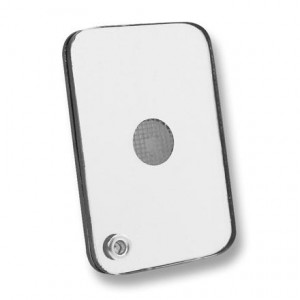 [Using the survival mirror successfully took some practice. It had a hole in the center used to sight the mirror at the SAR aircraft. We were taught to first hold it up without looking through the sighting hole so we could determine the proper orientation in relation to an ambient source of light. Once we found the reflection from the mirror on the terrain around us, we brought the mirror up and attempted to maintain the same orientation while trying to position the SAR aircraft in the sighting hole. The training sessions always ended up with, “Once they’ve seen you, don’t keep flashing them with the mirror or the SAR pilot might decide to leave you there.”]
[Using the survival mirror successfully took some practice. It had a hole in the center used to sight the mirror at the SAR aircraft. We were taught to first hold it up without looking through the sighting hole so we could determine the proper orientation in relation to an ambient source of light. Once we found the reflection from the mirror on the terrain around us, we brought the mirror up and attempted to maintain the same orientation while trying to position the SAR aircraft in the sighting hole. The training sessions always ended up with, “Once they’ve seen you, don’t keep flashing them with the mirror or the SAR pilot might decide to leave you there.”]
They made one pass, trying to go uphill, to hover, couldn’t hack the wind, played around a bit and got over me again. The guy said, ‘OK, now I can’t see you, you talk to me and tell me how to move in here’. I was telling him 4 feet right, 10 feet forward and things like that. So he got directly over me and I was there for about 15 seconds. I got a sinking feeling that they weren’t going to try to get me out and they were going to toss out a bundle. By this time, I didn’t want a bundle. Then they started this big yellow canopy down on the end of a cable [the forest penetrator]. Boy, I was happy to see that.
Oh, I forgot. I was using my .38, to people in the area, firing tracers. Nobody ever saw it. I jammed the .38 back in the holster. I’ll swear I put the thing shut. Evidently I didn’t. I know I had it when I started up the sling but I didn’t have it when I got out of the helicopter at Nakon Phanom. I guess it fell out. I was getting swung around pretty violently by the blast from the chopper blades and it must have fallen out.
Anyway, they got the thing down to me. They told me they had 240 feet of cable on the thing. They must have been 235 feet above me because the cable was just barely long enough. They dropped it to almost 5 feet from me and I was standing on this edge of the 20-foot rock and I couldn’t reach it. And, from where they were, they thought it was flat and they waved me over to take hold of it. I was waving them back towards me; I wasn’t going to jump and try to grab it. It must have been 10 or 15 seconds that they sat up there at the door waving me towards the thing and I kept shaking my head no and waving them back. They finally got the message, pulled the thing back and then when they banged it off the rocks it actually went passed me, pulled up a few feet and put it right in my hands.
I grabbed the seat down, unzipped the thing, sat down, pulled the strap out, put it around myself, clipped it and looked up at them. By that time I was airborne. It was a pretty wild ride really. They were having a tough time in the wind. They would bobble around a little bit. I got hit by a branch at the last of the top of the tree. They almost crammed me into the bottom of the helicopter pulling me up because it twisted the wrong way at the last second. I came within six inches of hitting the bottom of this thing and they swung it out away from the chopper and pulled it up real quick while I was on the outside swing and swung back right into the door, beautiful!
They grabbed me and pulled me inside. I think I got some of my bruises from the pounding that the two crewmen gave me on the back when I got in the chopper. They dragged me away from the door.
One of the things that I learned at Stead [Air Force Base, Nevada, home of the USAF basic survival training course] was don’t try to help them. Just hold on to the darned thing and they’ll get you inside and get you clear of the door until you’re safe and won’t fall back out. Then you can move on your own. Otherwise, stay right in the rescue device and don’t move around.
They dragged me away from the doors. I got up. You’d be amazed how shaky I suddenly was. I felt real good all the time I was on the ground, but as soon as I was safe I thought I was going to collapse right there on the spot. I sat down, pulled off some of my stinky old gear that by this time smelled of jungle rot, sweat and stuff like that. The guy handed me a ten-ounce medicine bottle full of something. I’m not sure, it said whiskey on it. It was the smoothest stuff I’ve ever saw. I drank all but an ounce of it in one gulp. It went down as smooth as could be.
He talked to me for a second. Asked me if I was hurting any place except my head. I said no. They peeled the bandage off. It was the second bandage I had put on, by the way. I had changed the dressing on the thing, poured a couple ounces of Merthiolate into it, while I was traveling. They took it off, looked at it, cleaned it up real well. It started bleeding a little bit, but they put a new bandage on it. Gave me a little water, I drank some water, took some more salt tablets because I suddenly had a craving for salt. They gave me a little damp cloth to sort of wipe off my face with. That was real good. About that time, they told me, I was already pretty well sure that though I hadn’t said anything to anybody, they told me definitely that I had walked across the line into North Vietnam. It seemed a little ironic, but it was the only way down that mountain.
I was going home. I walked up to the cockpit, shook hands with the pilot and co-pilot, told them how good it was to see them. They told me it was awfully good to finally get me out of there because they were tired of running back and forth trying to find me. I went back and sat down again. I hadn’t been hungry, really hungry, the whole time I was walking. But suddenly I was just ravenously hungry. But I couldn’t face any more jelly bars out of the C rations. They had about a half a can of shoe-string potatoes, which I devoured on the spot. I felt pretty good then. I just relaxed, really took it easy. They headed back.
The one kind of bad note of the whole thing was at 15 minutes after I was completely safe and everything in the world was rosy, Captain Bob Bush got shot down and they heard about it. [Capt Robert Edward “Bob” Bush, 421 TFS, KIA] They told me that Walnut Lead had just gone in. I didn’t know who it was at the time. That was too bad, I really felt bad about that, because they got me out, and I was completely unhurt, and was on my way back.
They took me to Nakhon Phanom [Royal Thai Air Force Base]. I climbed out of the helicopter and there must have been 40 people there. The whole complement of the base, I think. Congratulations all around, answered a few questions about their rescue effort. I was surprised at these guys — there were things that they were asking me I thought they should have had the answers to. I’m sure that they learned a couple of things out of this as far as the terrain over there. I don’t know if they ever picked anybody up in that particular area or not before. They were pretty well amazed at that.
The chopper crew — I talked to them for about 10 minutes. The same guys that picked me up were the same guys that had gotten there first the night before and kicked out the basket at me. They were really a cool crew. They did the job really well.
I was so tired and beaten by that time, I didn’t get their names and I’ve got to find out who they are and send them a letter. They were number one! They took me to the dispensary, cleaned up the wound a little more, dressed it a little better and talked about putting some sutures in it. They gave me a mirror and I looked at it about the fourth time that I had actually seen it and it was worse than before, swollen. He said there was no possible chance to making the thing match up so just leave it alone. He cleaned it up a little more and put a real tight pressure bandage on it. I washed up a little bit.
Went over and had a roast beef, French fries, salad, some tea. That was about the best meal I’d ever eaten. The co-pilot out of the chopper took me over to the officer’s quarters. I showered up, got all the grime and smell off of me. He gave me some of his own clothes to wear.
They bundled me out to an A-1E, in fact it was Sandy 31, the same guy who pretty well found me. Took off for Udorn. He asked me if I wanted to fly, from the back. Man, I couldn’t have flown a kite by that time – no thanks, go ahead! I nearly fell asleep in the bird. I was pretty drowsy and really worn out.
When we got to Udorn for the … Lord I lost count … for the umpty-umpth time they put a new bandage on my head. Every flight surgeon I ran into — a new bandage. I think they just wanted to see what it was like underneath.
They took me over to … it wasn’t TACC [Tactical Air Control Center] … it was some sort of intelligence group over there, ultra hush and they grilled me for two hours. They had a list of questions that were unbelievable, things that I hadn’t even been concerned with or thought about. They recorded it all, wrote all the answers down. They were particularly interested in these people I heard over on the ridge. They asked me if I heard about any friendlies in the area. It was a relatively safe position. Yes, supposed to be guys in there with khaki uniforms, white armbands and red berets.
As far as I’m concerned, anybody can wear a khaki uniform, a white armband, and a red beret. He laughed, and it was a sort of laugh that sort of gave the impression that somebody else had already gotten shot at or in trouble because of it. I wouldn’t advise, from the impression he gave me, anybody taking this too literally. Anybody over there would have a pretty good chance they would not be the right guys they run into.
That was about it. I drank three Pepsi Colas, I think, because I was still pretty well dehydrated. Staggered over to the Q [Bachelor Officer’s Quarters], and passed out for eight hours. Got up the next morning, and there was Smiling Jack Bailey right there at the door. He told me he was headed on home. I assume I had a few hours. I got the Gooney Bird out of Udorn and flew back to Nakhon Phanom, just long enough to let four people jump out and took off again. I got home, climbed down, and sprayed Champagne all over the Colonel. [End of tape 1]
The taped interview continued for another 30 minutes. It was recorded on one side of a second tape. During this part of the interview, the group discussed with Lt Thomas the performance of his survival equipment. Thomas described in detail how he used each item in his equipment pack. Some equipment, such as radios and his boots were vital in his successful evasion and rescue. Other equipment such as his single pair of gloves didn’t withstand the rigors of his evasion. He also discussed what he had learned during his survival courses, none of which was on jungle survival. He attributed his successful evasion to his upbringing.
“I was better off with my ole farm boy intuition and knowledge of outdoors than any training I had. I wasn’t the least bit worried about being out there by myself. I knew I could hack it. … They asked me up at Udorn that if I had one word of wisdom to say to anybody, what would it be? … Stay calm and use your head, particularly use your head. … Quite a walk!”
Postscript to the Ken Thomas story salvaged by Howard Plunkett:
When Ken was rescued, 25 March 1966, USAF had no policy on pilots returning to flight after being shot down. I told Ken that we, the 469th CO and Ops, would send him home. He asked if he had to go home. I told him there was no firm policy. He chose to remain at Korat [Royal This Air Force Base] to fly his 100 missions. On 5 May he was shot down again, KIA. It was a difficult story to tell his mother later. Ken was not married. Bob Krone, OPS and CO, 469th. TFS, Korat, 13 Nov 1965 — 6 June 1966

